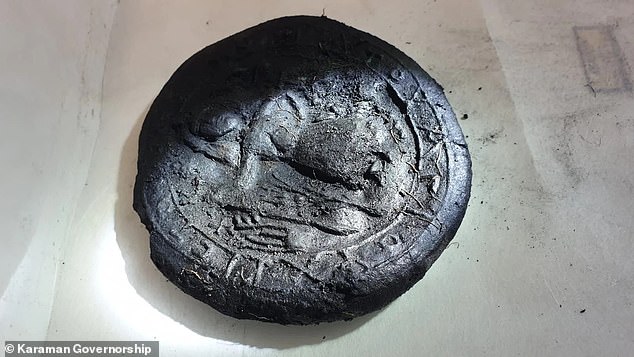Archaeologists have uncovered a trove of 1,300-year-old bread loaves that brings one of the Bible’s most famous verses to life.
At Topraktepe, the site of ancient Eirenopolis in Turkey, researchers discovered five carbonized loaves, one bearing a portrait of Jesus and an ancient Greek inscription reading, ‘With our thanks to Blessed Jesus.’
The work, conducted under the direction of the Karaman Museum Directorate, made it possible to recover these fragile organic remains thanks to a natural carbonization process.
Exposure to fire under specific conditions of temperature and lack of oxygen preserved the loaves with exceptional detail, described by experts as the best-documented examples of their kind in all of Anatolia.
The discovery vividly brings John 6:35 to life, the verse where Jesus declares, ‘I am the bread of life.’
For the people of Eirenopolis, these loaves were not mere food, but were sacred objects, ritually treated as representations of Christ himself.
Unlike the traditional Pantocrator images, the Topraktepe loaf shows Jesus as a sower, linking faith to daily labor and the hope of a bountiful harvest.
The other four loaves feature cross-shaped imprints, further suggesting they were used in early Christian rituals as Eucharistic or communion bread.

The finding vividly echoes John 6:35, where Jesus declares, ‘I am the bread of life.’ For the people of Eirenopolis, this bread was not just food but a sacred object, literally and ritually treated as a representation of Christ
Preliminary analyses suggest that the ‘Sower Jesus’ image was far more than decorative.
Archaeologists suggested it conveyed profound symbolic meaning, highlighting divine blessing over agricultural labor, using the hope for a bountiful harvest as a metaphor for spiritual redemption and celebrating the sanctity of daily work and sustenance.
In essence, the depiction reflects a form of popular piety in which Christ embodied the rhythms and labors of ordinary life.
The combination of the Greek inscription expressing gratitude, the distinctive ‘Farming Jesus’ iconography, and the Maltese Cross motifs on the loaves has led researchers to a strong working hypothesis: these are very likely communion breads used in the central Christian ritual of the Eucharist.
In Byzantine Christian practice, bread used in the Eucharist symbolized the body of Christ, with leavened loaves in the East representing life and resurrection.
While texts and icons describe these rituals, few physical specimens survive.
The Topraktepe loaves, preserved with exceptional clarity, provided tangible evidence of how early Christians enacted their devotion through everyday objects like bread.

A total of five loaves were uncovered, many of which featured cross-shaped patterns

The ancient loaves were found at Topraktepe, the site of ancient Eirenopolis in Turkey
Topraktepe, also known as the ‘City of Peace,’ served as an important bishopric center during the Roman and Byzantine periods.
Located near today’s Ermenek district, Eirenopolis occupied a strategic point on the Anemurium–Isaura trade route, connecting the Mediterranean coast with inland Anatolia.
Archaeological surveys reveal fortified city walls, rock-cut dwellings, and extensive necropolises, reflecting both its defensive significance and its role as a religious and administrative hub.
As a bishopric under the Patriarchate of Constantinople, the city was closely tied to broader Byzantine ecclesiastical networks, which shaped its liturgical traditions
The Topraktepe discovery resonates with Jesus’ teachings at the synagogue in Capernaum, a town on the northern shore of the Sea of Galilee, where he performed miracles, healing the sick, casting out demons, and restoring the paralyzed.
It was there he declared, ‘I am the bread of life,’ linking spiritual nourishment to physical sustenance.
The ‘Sower Jesus’ image on the loaf reflects this same principle, portraying Christ as a provider who blesses both labor and harvest
This article was originally published by a www.dailymail.co.uk . Read the Original article here. .

